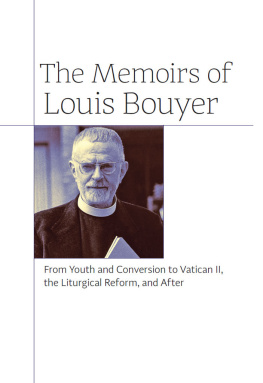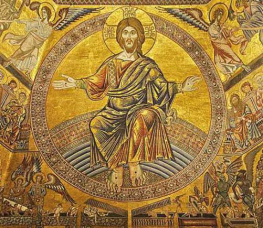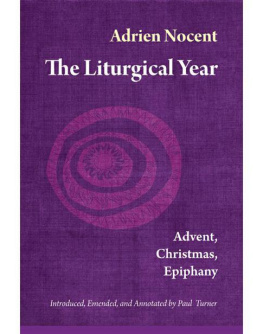THE ORGANIC DEVELOPMENT
OF THE LITURGY
ALCUIN REID, O.S.B.
The Organic Development
of the Liturgy
The Principles of Liturgical Reform and Their Relation
to the Twentieth-Century Liturgical Movement
Prior to the Second Vatican Council
Second Edition
IGNATIUS PRESS SAN FRANCISCO
Cover art:
Christmas Mass (15th century)
From the Trs Riches Heures du Duc de Berry, MS. 65, fol. 158
Photo by Rene-Gabriel Ojeda
Muse Cond, Chantilly, France
Runion des Muses Nationaux / Art Resource, New York
2005 Ignatius Press, San Francisco
All rights reserved
ISBN 978-1-58617-106-3
ISBN 1-58617-106-2
Library of Congress Control Number 2005926544
Printed in the United States of America
Contents
Introduction
Early Liturgical Development
The Sixth to Eleventh Centuries and the Carolingian Reform
The Later Middle Ages
Saint Thomas Aquinas
Contemporary Views of Medieval and Renaissance Liturgy
The Liturgical Reform of Cardinal Quignonez
The Council of Trent
The Legacy of the Council of Trent
The Breviary Reform of Pope Clement VIII
The Breviary Reform of Pope Urban VIII
The Proposed Breviary Reform of Cardinal Tommasi
Enlightenment and Gallican Liturgical Reforms
Dom Gurangers Response to Gallicanism
The Proposals for Reform of Pope Benedict XIV
Liturgical Piety
John Henry Cardinal Newman
Anglican Orders
Historical Research
Conclusion
Introduction
Pope Saint Pius X
Dom Lambert Beauduin, and the Foundations of the Liturgical Movement
Joseph Gttler
Adrian Fortescue
The Benedictines of Farnborough
Romano Guardini
Dom Theodore Wesseling, O.S.B .
Dom Virgil Michel, O.S.B .
Orate Fratres Discussion of the Principles of Liturgical Reform
Pius Parsch
The North American Liturgical Weeks
Martin Hellriegel
Dom Odo Casel, O.S.B .
Anton Baumstark
Gerald Ellard, S.J .The Mass of the Future
The Holy See and Liturgical Reform up to 1948
Beauduins 1945 Norms for Liturgical Reform
Pope Pius XII Mediator Dei
Conclusion
Introduction
The Pian Commission for Liturgical Reform
Josef Andreas Jungmann, S.J .
The 1951 Reform of the Paschal Vigil
Louis Bouyers 1951 Criticisms of the Liturgical Movement
The Maria Laach Conference, 1951
The Mont Sainte-Odile Conference, 1952
The Lugano Conference, 1953
The Mont-Csar Conference, 1954
Evening Mass
Ernest Koenkers 1954 Assessment of the Liturgical Renaissance
The 1955 Australian Liturgical Week
The 1955 Simplification of the Rubrics
Annibale Bugninis Rationale for Liturgical Reform
The 1955 Reform of Holy Week
The Encyclical Music Sacr Disciplina
The Assisi Congress, 1956
The 1957 Decree on the Tabernacle and the Altar
The 1957 Consultation on Breviary Reform
The 1958 Instruction on Sacred Music and the Liturgy
Further Liturgical Congresses
Permission for the Use of the Vernacular
Publications on Liturgical Reform
The Final Work of the Pian Commission
Conclusion
Preface
In the last few decades, the matter of the right way to celebrate the Liturgy has increasingly become one of the points around which much of the controversy has centred concerning the Second Vatican Council, about how it should be evaluated, and about its reception in the life of the Church. There are the relentless supporters of reform, for whom the fact that, under certain conditions, the celebration of the Eucharist in accordance with the most recent edition of the missal before the Councilthat of 1962has once more been permitted represents an intolerable fall from grace. At the same time, of course, the Liturgy is regarded as semper reformanda, so that in the end it is whatever congregation is involved that makes its Liturgy, in which it expresses itself. A Protestant Liturgical Compendium (edited by C. Grethlein [Ruddat, 2003]) recently presented worship as a project for reform (pp. 13-41) and thereby also expressed the way many Catholic liturgists think about it. And then, on the other hand, there are the embittered critics of liturgical reformcritical not only of its application in practice, but equally of its basis in the Council. They can see salvation only in total rejection of the reform. Between these two groups, the radical reformers and their radical opponents, the voices of those people who regard the Liturgy as something living, and thus as growing and renewing itself both in its reception and in its finished form, are often lost. These latter, however, on the basis of the same argument, insist that growth is not possible unless the Liturgys identity is preserved, and they further emphasise that proper development is possible only if careful attention is paid to the inner structural logic of this organism: Just as a gardener cares for a living plant as it develops, with due attention to the power of growth and life within the plant and the rules it obeys, so the Church ought to give reverent care to the Liturgy through the ages, distinguishing actions that are helpful and healing from those that are violent and destructive.
If that is how things are, then we must try to ascertain the inner structure of a rite, and the rules by which its life is governed, in order thus to find the right way to preserve its vital force in changing times, to strengthen and renew it. Dom Alcuin Reids book takes its place in this current of thought. Running through the history of the Roman rite (Mass and breviary), from its beginnings up to the eve of the Second Vatican Council, it seeks to establish the principles of liturgical development and thus to draw from historyfrom its ups and downsthe standards on which every reform must be based. The book is divided into three parts. The first, very brief part investigates the history of the reform of the Roman rite from its beginnings up to the end of the nineteenth century. The second part is devoted to the Liturgical Movement up to 1948. By far the longest partthe thirddeals with liturgical reform under Pius XII up to the eve of the Second Vatican Council. This part is most useful, because to a great extent people no longer remember that particular phase of liturgical reform, yet in that periodas, of course, also in the history of the Liturgical Movementwe see reflected all the questions concerning the right way to go about reform, so that we can also draw out from all this criteria on which to base our judgments. The author has made a wise decision in stopping on the threshold of the Second Vatican Council. He thus avoids entering into the controversy associated with the interpretation and the reception of the Council. Yet he can nonetheless show its place in history and show us the interplay of various tendencies on which questions as to the standards for reform must be based.
At the end of his book, the author enumerates some principles for proper reform: it should keep openness to development and continuity with the Tradition in a proper balance; it should include awareness of an objective liturgical tradition and therefore take care to ensure a substantial continuity. The author then agrees with the Catechism of the Catholic Church in emphasising that even the supreme authority in the Church may not change the liturgy arbitrarily, but only in the obedience of faith and with religious respect for the mystery of the liturgy (CCC 1125). As subsidiary criteria we then encounter the legitimacy of local traditions and the concern for pastoral effectiveness.
From my own personal point of view I should like to give further particular emphasis to some of the criteria for liturgical renewal thus briefly indicated. I will begin with those last two main criteria. It seems to me most important that the Catechism , in mentioning the limitation of the powers of the supreme authority in the Church with regard to reform, recalls to mind what is the essence of the primacy as outlined by the First and Second Vatican Councils: The pope is not an absolute monarch whose will is law; rather, he is the guardian of the authentic Tradition and, thereby, the premier guarantor of obedience. He cannot do as he likes, and he is thereby able to oppose those people who, for their part, want to do whatever comes into their head. His rule is not that of arbitrary power, but that of obedience in faith. That is why with respect to the Liturgy, he has the task of a gardener, not that of a technician who builds new machines and throws the old ones on the junk-pile. The rite, that form of celebration and prayer which has ripened in the faith and the life of the Church, is a condensed form of living Tradition in which the sphere using that rite expresses the whole of its faith and its prayer, and thus at the same time the fellowship of generations one with another becomes something we can experience, fellowship with the people who pray before us and after us. Thus the rite is something of benefit that is given to the Church, a living form of paradosis , the handing-on of Tradition.
Next page
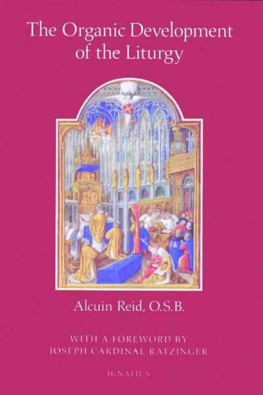

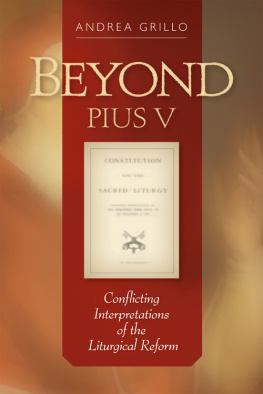
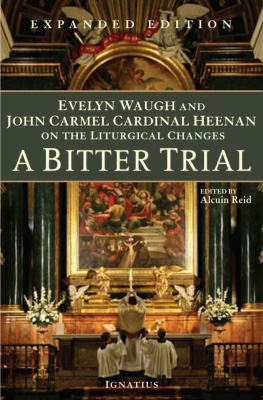
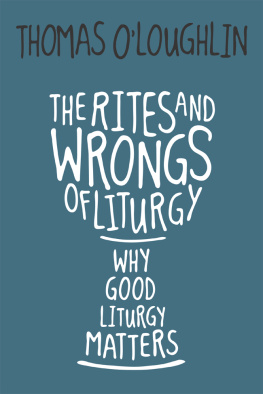
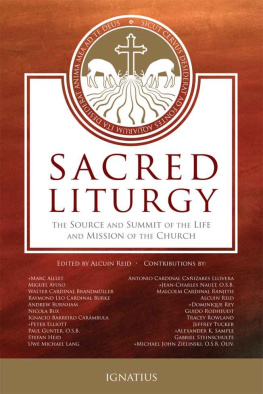
![Pope John XXIII - The Roman Missal [1962]](/uploads/posts/book/272720/thumbs/pope-john-xxiii-the-roman-missal-1962.jpg)
